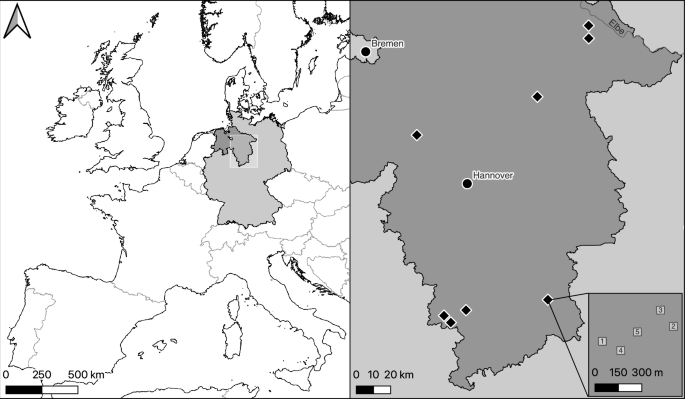Douglas fir and Norway spruce have similar effects on small mammal density, but not survival, in Central European managed forests
IF 16.4
1区 化学
Q1 CHEMISTRY, MULTIDISCIPLINARY
引用次数: 0
Abstract
Abstract In an effort to ameliorate the impacts of climate change, forest managers in Central Europe increasingly turn to conifer species that produce higher yields and are better adapted to projected future climatic conditions. Though small mammals are an important component of the forest ecosystem, the impacts of enriching native broadleaf forests with conifers on small mammal communities are not well understood. We conducted mark–recapture surveys of small mammals to ascertain differences in their community structure among stands of two conifers (native Norway spruce Picea abies and non-native Douglas fir Pseudotsuga menziesii ) and the dominant broadleaf in the region, European beech ( Fagus sylvatica ). After estimating the density of two common species, the yellow-necked mouse Apodemus flavicollis and bank vole Clethrionomys glareolus , we found that the population density of each is positively related to the proportion of beech and negatively to the proportion of conifers in each stand, though these effects of stand composition are smaller than the positive effect of herb cover. Increasing Norway spruce proportion reduced monthly survival of small mammals, while Douglas fir proportion had a positive effect on survival. We conclude that the two conifer species have similar impacts on small mammal density, though overall small mammal survival was significantly lower on plots with Norway spruce. This suggests that increasing the proportion of Douglas fir at the expense of Norway spruce may be possible without significantly changing local patterns of small mammal population density, but further research is necessary to elucidate the exact impacts of these two conifer species on small mammal demography and behavior.

在中欧的管理森林中,道格拉斯冷杉和挪威云杉对小型哺乳动物的密度有类似的影响,但对存活率没有影响
为了减轻气候变化的影响,中欧的森林管理者越来越多地转向种植产量更高、更能适应未来气候条件的针叶树。尽管小型哺乳动物是森林生态系统的重要组成部分,但目前还不清楚针叶林对小型哺乳动物群落的影响。我们对小型哺乳动物进行了重新捕获调查,以确定两种针叶树(原生挪威云杉和非原生道格拉斯冷杉)和该地区主要阔叶植物欧洲山毛榉(Fagus sylvatica)林分之间的群落结构差异。通过对黄颈鼠(Apodemus flavicollis)和滨田鼠(Clethrionomys glareolus)两种常见物种的密度进行估算,发现两种物种的种群密度与山毛榉占比呈正相关,与针叶树占比负相关,但林分构成的影响小于草本盖度的正相关。增加挪威云杉比例降低了小兽类的月存活率,而花旗松比例对小兽类的月存活率有积极影响。我们得出结论,两种针叶树对小型哺乳动物的密度有相似的影响,尽管挪威云杉样地的总体小型哺乳动物存活率明显较低。这表明,在不显著改变当地小型哺乳动物种群密度格局的情况下,以挪威云杉为代价增加花旗松的比例是可能的,但需要进一步的研究来阐明这两种针叶树对小型哺乳动物种群数量和行为的确切影响。
本文章由计算机程序翻译,如有差异,请以英文原文为准。
求助全文
约1分钟内获得全文
求助全文
来源期刊

Accounts of Chemical Research
化学-化学综合
CiteScore
31.40
自引率
1.10%
发文量
312
审稿时长
2 months
期刊介绍:
Accounts of Chemical Research presents short, concise and critical articles offering easy-to-read overviews of basic research and applications in all areas of chemistry and biochemistry. These short reviews focus on research from the author’s own laboratory and are designed to teach the reader about a research project. In addition, Accounts of Chemical Research publishes commentaries that give an informed opinion on a current research problem. Special Issues online are devoted to a single topic of unusual activity and significance.
Accounts of Chemical Research replaces the traditional article abstract with an article "Conspectus." These entries synopsize the research affording the reader a closer look at the content and significance of an article. Through this provision of a more detailed description of the article contents, the Conspectus enhances the article's discoverability by search engines and the exposure for the research.
 求助内容:
求助内容: 应助结果提醒方式:
应助结果提醒方式:


